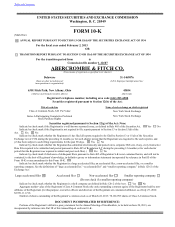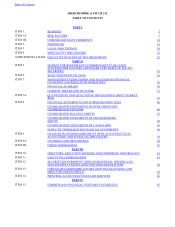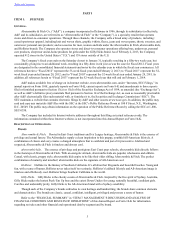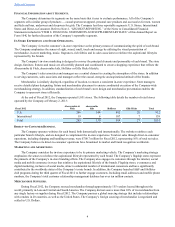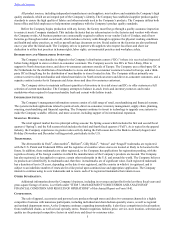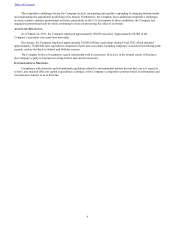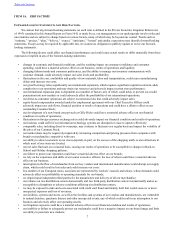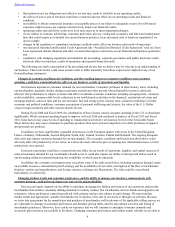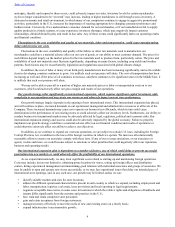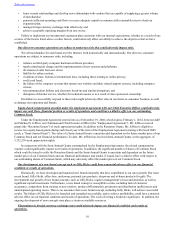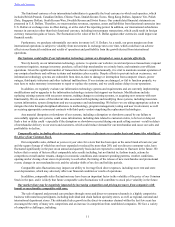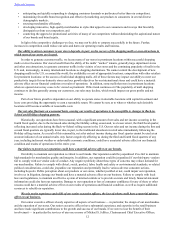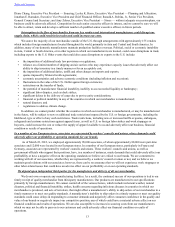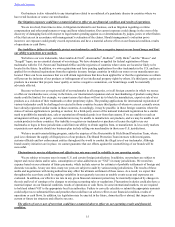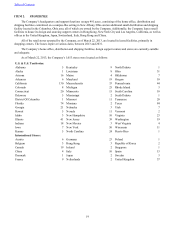Abercrombie & Fitch 2013 Annual Report Download - page 10
Download and view the complete annual report
Please find page 10 of the 2013 Abercrombie & Fitch annual report below. You can navigate through the pages in the report by either clicking on the pages listed below, or by using the keyword search tool below to find specific information within the annual report.
10
• foster current relationships and develop new relationships with vendors that are capable of supplying a greater volume
of merchandise;
• generate sufficient operating cash flows or secure adequate capital on commercially reasonable terms to fund our
expansion plan;
• manage foreign currency exchange risks effectively; and
• achieve acceptable operating margins from new stores.
Failure to implement our international expansion plan consistent with our internal expectations, whether as a result of one
or more of the factors listed above or other factors, could adversely affect our ability to achieve the objectives that we have
established.
Our direct-to-consumer operations are subject to numerous risks that could adversely impact sales.
We sell merchandise for each brand over the Internet, both domestically and internationally. Our direct-to-consumer
operations are subject to numerous risks, including:
• reliance on third-party computer hardware/software providers;
• rapid technological change and the implementation of new systems and platforms;
• diversions of sales from our stores;
• liability for online content;
• violations of state, federal or international laws, including those relating to online privacy;
• credit card fraud;
• the failure of the computer systems that operate our websites and their related support systems, including computer
viruses;
• telecommunication failures and electronic break-ins and similar disruptions; and
• disruption of Internet service, whether for technical reasons or as a result of state-sponsored censorship.
Our failure to successfully respond to these risks might adversely affect sales in our direct-to-consumer business, as well
as damage our reputation and brands.
Equity-based compensation awarded under the employment agreement with our Chief Executive Officer could adversely
impact our cash flows, financial position or results of operations and could have a dilutive effect on our outstanding
Common Stock.
Under the Employment Agreement entered into as of December 19, 2008, which expires February 1, 2014, between A&F
and Michael S. Jeffries, our Chairman and Chief Executive Officer (the “Employment Agreement”), Mr. Jeffries received
grants (the “Retention Grants”) of stock appreciation rights. In addition to the Retention Grants, Mr. Jeffries is eligible to
receive two equity-based grants during each fiscal year of the term of the Employment Agreement starting with Fiscal 2009
(each, a “Semi-Annual Grant”). The value of a Semi-Annual Grant is uncertain and dependent on the future market price of our
Common Stock and our financial performance. To date, Mr. Jeffries has received Semi-Annual Grants, in the aggregate, of
3,752,259 stock appreciation rights.
In connection with the Semi-Annual Grants contemplated by the Employment Agreement, the related compensation
expense could significantly impact our results of operations. In addition, the significant number of shares of Common Stock
which could be issued to settle the Retention Grants and the Semi-Annual Grants is uncertain and dependent on the future
market price of our Common Stock and our financial performance and would, if issued, have a dilutive effect with respect to
our outstanding shares of Common Stock, which may adversely affect the market price of our Common Stock.
Our development of a new brand concept such as Gilly Hicks could have a material adverse effect on our financial
condition or results of operations.
Historically, we have developed and launched new brands internally that have contributed to our sales growth. Our most
recent brand, Gilly Hicks, offers bras, underwear, personal care products, sleepwear and at-home products for girls. The
development and growth of new brand concepts, such as Gilly Hicks, requires management’s focus and attention, as well as
significant capital investments. Furthermore, a new brand concept is susceptible to risks, including lack of customer
acceptance, competition from existing or new retailers, product differentiation, production and distribution inefficiencies and
unanticipated operating issues. There is no assurance that a new brand concept, including Gilly Hicks, will achieve successful
results. The failure of Gilly Hicks to be launched and expanded successfully, and to achieve profitability, could have a material
adverse effect on our financial condition and results of operations. The costs of exiting a brand are significant. In addition, the
ongoing development of new concepts may place a strain on available resources.
Fluctuations in foreign currency exchange rates could adversely impact our financial condition and results of
operations.
Table of Contents

